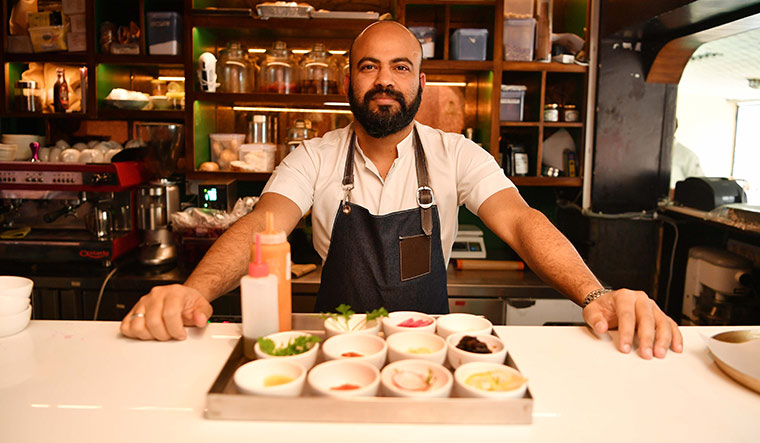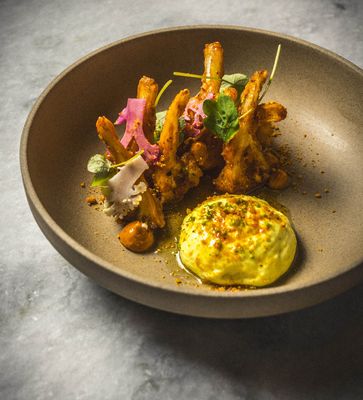Gobi 65, also served as gobi manchurian, is a much-reviled fixture in Indian-Chinese or ‘multi-cuisine’ restaurants. These deep-fried cauliflower florets tossed in a jumble of spices cause food purists and critics to scream blasphemy and betrayal. But Chef Sujan Sarkar does not believe in putting Indian food in a box. For him, modern Indian food—a term quite loosely bandied about—has to have an Indian backbone, but it should also reflect the changing eating habits and aspirations of an India rapidly surging ahead. So, in a six-month pop-up of his successful New York gastropub Baar Baar, set up in New Delhi’s spiffy Khan Market, homage is paid to Gobi 65 as Cauliflower Koliwada. It derives its name from the spicy Maharashtrian fried fish snack, fish koliwada.
The cauliflower and broccoli florets have to be seasonal for best quality finds. In New York, Sarkar sources a sweet-stemmed variety of cauliflower from Japan. The chili paste marinated over the flowers do not scorch one’s oesophagus like a fireball; their flavours individually explode like some profound, intricate sauce-and-spice melange. These strikingly dressed cauliflowers are served alongside rice hollandaise, peanut chutney and thecha. While thecha is a Maharashtrian green chili table sauce, rice hollandaise is nothing but a smooth paste of blended curd rice. It is no wonder that Sarkar often uses the word “elevate” to describe his brand of modern Indian.
Over the years, we have seen many flag-bearers of modern Indian food reposition and refine the country’s culinary heritage for a more well-heeled clientele. Names which really broke the code include Floyd Cardoz in New York and Vineet Bhatia in London, followed by Gaggan Anand in Bangkok. Closer home, in an arguably more difficult terrain, there is Manish Mehrotra of Indian Accent, Thomas Zacharias of The Bombay Canteen and Manu Chandra of the Monkey Bar chain of restaurants. It can be daunting to follow in the footsteps of these already established names. But Sarkar, 40, has his eye on the ball with his interplay of modernist techniques and regional flavours. “Mostly it is all about ingredients,” he says. “I pay respect to each and every ingredient I use. And understand their source and history. That is the future of modern Indian food.”
His Cheese Thali is an eclectic maze of locally sourced artisanal cheeses like crumb-fried kalari from Jammu, Kodai Cambrie, Himalayan natural gouda, Manali asiago and Auroville apricot cream cheese, served with chutney, murabba (sweet fruit preserve) and charred makki ki rotis (maise roti). Pork ribs, so popular in India, have inspired Kashmiri-style lamb ribs. There is green pea kulcha speckled with shavings of goat cheese and black truffle; Coorgi Pandi (pork) curry served with rice noodles, poached egg and crispy wild chives; while his Nalli Nihari is cooked in the Spanish sauce ‘mole’, with chocolate and chili. Kolkata’s chingri (prawn) malai curry is transmogrified by combining it with Japanese uni or sea urchin.
With an unwavering commitment to experimentation and a keen eye to foresee trends, Sarkar has been in the business of elevating Indian food for a while now. Having trained in European cooking techniques, he cut his teeth in the London dining scene for over a decade, when he worked in Jamie Oliver’s Fifteen, Galvin at Windows, Viajante and Automat in Mayfair.
Sarkar came back to India and joined the Olive Bar & Kitchen in 2013, where he was part of the more experimental, exclusive culinary project—The Tasting Lab—at Greenhouse on the Ridge, Olive Qutub, as Olive’s culinary director and chef de cuisine. At the 22-seater dining space, he played around with the “slow-food” fad and molecular gastronomy (which he now dislikes). He served scallops with ice apples (or taal shash) structured to resemble a Japanese jelly, and made duck liver ice cream lollypops dunked in cocoa butter and hazelnuts in a nine-course, “no-rule” menu.
His first-of-its-kind cocktail bar, Ek Bar, wooed Delhi with artisanal cocktails strictly inspired by Indian flavours, before he headed to the US to set up Rooh, a fine-dining Indian restaurant in San Francisco. But for now, he is charged about serving Indian Tapas-style food at Baar Baar in New York, a grand, 200-seater gastropub in East Village which opened its doors in December 2017. Its vibe is informal and classy without being stifling. “It is not fine-dining. It is just fine food,” Sarkar says before adding, “I am going to change the perception of Indian food in the west.” For someone who badly wanted to be a fashion designer once, Sarkar has progressed fast with his version of progressive Indian food.



